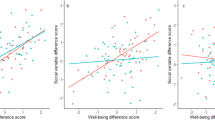Abstract
The relative impact of genetic and social influences on disordered eating behaviors (DEB) including binging, purging, excessive dieting and negative self-evaluations about weight remain an issue of debate. The current study sought to examine the relative influence of genetic and social influences on DEB. A 7-year prospective analysis of 580 monozygotic (MZ) and dizygotic (DZ) twins was conducted. Estimates of heritability of DEB were obtained using the DF Analysis Model. Regression equations revealed the relative predictive value of sibling’s DEB, neurotic personality, maternal warmth and television and video game exposure on DEB. Heritability estimates for DEB were 0.40 for females and 0.48 for males. Among MZ and DZ twin pairs, female sex, neurotic personality and a genetic variable component, but not maternal warmth or school related problems, predicted DEB. Contrary to the expectations of media effects theory, greater media use was associated with lower DEB among DZ twins and had no influence on MZ twins. These results indicate that DEB is highly heritable and that personality variables may play an important role in the formation of DEB. This suggests that it is important to control for genetic variables when analyzing risk factors for DEB.

Similar content being viewed by others
References
American Psychiatric Association: Diagnostic and Statistical Manual-IV-Text Revision. Washington, DC, American Psychiatric Association, 2000
Stice E, Shaw H: Role of body dissatisfaction in the onset and maintenance of eating pathology: A synthesis of research findings. Journal of Psychosomatic Research 53(5):985–993, 2002
Sullivan P, Bulik C, Kendler K: Genetic epidemiology of binging and vomiting. British Journal of Psychiatry 173:75–79, 1998
Klump K, Miller K, Keel P, McGue M, Iacono W: Genetic and environmental influences on anorexia nervosa syndromes in a population-based twin sample. Psychological Medicine: A Journal of Research in Psychiatry and the Allied Sciences 31(4):737–740, 2001
Wade T, Wilkinson J, Ben-Tovim D: The genetic epidemiology of body attitudes, the attitudinal component of body image in women. Psychological Medicine: A Journal of Research in Psychiatry and the Allied Sciences 33(8):1395–1405, 2003
MacLaren V, Best L: Female students’ disordered eating and the big five personality facets. Eating Behaviors 10(3):192–195, 2009
Miller J, Schmidt L, Vaillancourt T, McDougall P, Laliberte M: Neuroticism and introversion: A risky combination for disordered eating among a non-clinical sample of undergraduate women. Eating Behaviors 7(1):69–78, 2006
Cooley E, Toray T, Wang M, Valdez N: Maternal effects on daughters’ eating pathology and body image. Eating Behaviors 9(1):52–61, 2008
Neumark-Sztainer D, Bauer K, Friend S, Hannan P, Story M, Berge J: Family weight talk and dieting: How much do they matter for body dissatisfaction and disordered eating behaviors in adolescent girls? Journal of Adolescent Health 47(3):270–276, 2010
American Psychological Association: Report of the APA task force on the sexualization of girls. Accessed 9 Oct 2011 from http://www.apa.org/pi/wpo/sexualization_report_summary.pdf, 2007
Ferguson C, Winegard B, Winegard B: Who is the fairest one of all? How evolution guides peer and media influences on female body dissatisfaction. Review of General Psychology 15(1):11–28, 2011
Holmstrom A: The effects of the media on body image: A meta-analysis. Journal of Broadcasting and Electronic Media 48(2):196–217, 2004
Want S: Meta-analytic moderators of experimental exposure to media portrayals of women on female appearance satisfaction: Social comparisons as automatic processes. Body Image 6(4):257–269, 2009
Resnick M, Bearman P, Udry J, et al.: Protecting adolescents from harm: Findings from the National Longitudinal Study on Adolescent Health. Journal of the American Medical Association 278(10):823–832, 1997
Ferguson C: A meta-analysis of normal and disordered personality across the life span. Journal of Personality and Social Psychology 98(4):659–667, 2010
Terracciano A, McCrae R, Costa P: Intra-individual change in personality stability and age. Journal of Research in Personality 44(1):31–37, 2010
Rodgers J, Kohler H: Reformulating and simplifying the DF analysis model. Behavior Genetics 35(2):211–217, 2005
Klump K, Bulik C, Kaye W, Treasure J, Tyson E: Academy for eating disorders position paper: Eating disorders are serious mental illnesses. International Journal of Eating Disorders 42(2):97–103, 2009
Author information
Authors and Affiliations
Corresponding author
Rights and permissions
About this article
Cite this article
Ferguson, C.J., Muñoz, M.E., Winegard, B. et al. The Influence of Heritability, Neuroticism, Maternal Warmth and Media Use on Disordered Eating Behaviors: A Prospective Analysis of Twins. Psychiatr Q 83, 353–360 (2012). https://doi.org/10.1007/s11126-012-9205-7
Published:
Issue Date:
DOI: https://doi.org/10.1007/s11126-012-9205-7




